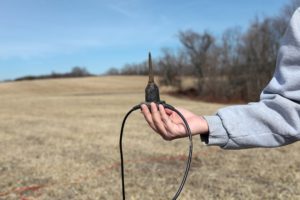All Categories
Featured
Table of Contents
How A Geophysical Survey Is Crucial To Offshore Wind Farm ... in Clarkson Australia 2020

(PREM)., and the boundaries in between layers of the mantle are consistent with phase shifts.

This makes plate tectonics possible. Schematic of Earth's magnetosphere. The solar wind flows from delegated right. If a planet's magnetic field is strong enough, its interaction with the solar wind forms a magnetosphere. Early area probes mapped out the gross dimensions of the Earth's electromagnetic field, which extends about 10 Earth radii towards the Sun.
Inside the magnetosphere, there are reasonably dense regions of solar wind particles called the Van Allen radiation belts. Geophysical measurements are typically at a particular time and location.
Geophysicists in Jolimont WA 2020
, integrates huge collaborates and the regional gravity vector to get geodetic coordinates. This method only supplies the position in two collaborates and is more challenging to use than GPS.
Relative positions of two or more points can be identified utilizing very-long-baseline interferometry. Gravity measurements became part of geodesy due to the fact that they were required to related measurements at the surface area of the Earth to the recommendation coordinate system. Gravity measurements on land can be used gravimeters deployed either on the surface or in helicopter flyovers.
Satellites in area have actually made it possible to gather information from not just the visible light region, however in other locations of the electro-magnetic spectrum. The planets can be defined by their force fields: gravity and their magnetic fields, which are studied through geophysics and area physics. Determining the changes in acceleration experienced by spacecraft as they orbit has actually enabled fine details of the gravity fields of the worlds to be mapped.
Exploration Geophysicist: Occupations In Alberta in Kinross Australia 2020

Given that geophysics is worried with the shape of the Earth, and by extension the mapping of features around and in the world, geophysical measurements consist of high precision GPS measurements. Once the geophysical measurements have been processed and inverted, the translated outcomes are plotted utilizing GIS.
Lots of geophysics companies have actually developed internal geophysics programs that pre-date Arc, GIS and Geo, Soft in order to fulfill the visualization requirements of a geophysical dataset. Exploration geophysics is applied geophysics that frequently uses remote noticing platforms such as; satellites, aircraft, ships, boats, rovers, drones, borehole picking up devices, and seismic receivers.
For example, aeromagnetic information (aircraft gathered magnetic information) collected utilizing conventional fixed-wing aircraft platforms should be fixed for electro-magnetic eddy currents that are produced as the aircraft moves through Earth's electromagnetic field. There are likewise corrections connected to modifications in measured potential field intensity as the Earth turns, as the Earth orbits the Sun, and as the moon orbits the Earth.
What's The Difference Between A Geotechnical And ... in Mirrabooka Oz 2023
Signal processing involves the correction of time-series information for undesirable sound or mistakes presented by the measurement platform, such as airplane vibrations in gravity data. It also involves the decrease of sources of sound, such as diurnal corrections in magnetic information. In seismic data, electromagnetic data, and gravity information, processing continues after error corrections to consist of computational geophysics which lead to the last interpretation of the geophysical information into a geological analysis of the geophysical measurements Geophysics emerged as a separate discipline just in the 19th century, from the intersection of physical geography, geology, astronomy, meteorology, and physics.
The magnetic compass existed in China back as far as the 4th century BC. It was not up until excellent steel needles might be forged that compasses were utilized for navigation at sea; prior to that, they might not maintain their magnetism long enough to be helpful.
By looking at which of eight toads had the ball, one could determine the instructions of the earthquake. It was 1571 years before the very first design for a seismoscope was released in Europe, by Jean de la Hautefeuille. It was never developed. Among the publications that marked the beginning of modern science was William Gilbert's (1600 ), a report of a series of precise experiments in magnetism.
Geophysicist Job Description: Salary, Duties, & More in Gosnells Aus 2023
Dietmar; Sdrolias, Maria; Gaina, Carmen; Roest, Walter R. (April 2008). "Age, spreading rates, and spreading out asymmetry of the world's ocean crust". Geochemistry, Geophysics, Geosystems. 9 (4 ): Q04006. Bibcode:2008 GGG ... 9. 4006M. doi:10. 1029/2007GC001743. S2CID 15960331. "Earth's Inconstant Electromagnetic field". science@nasa. National Aeronautics and Area Administration. 29 December 2003. Retrieved 13 November 2018.
Leipzig. Berlin (Gebruder Borntraeger). Runcorn, S.K, (editor-in-chief), 1967, International dictionary of geophysics:. Pergamon, Oxford, 2 volumes, 1,728 pp., 730 fig Geophysics, 1970, Encyclopaedia Britannica, Vol. 10, p. 202-202 Ross 1995, pp. 236242 Shearer, Peter M. (2009 ). Introduction to seismology (2nd ed.). Cambridge: Cambridge University Press. ISBN 9780521708425. Stphane, Sainson (2017 ).
Latest Posts
Where Can A Geophysicist Work Other Than The Oil Industry? in Ellenbrook Oz 2021
Geophysicist in Como Aus 2022
Geophysical Surveys Definition & Meaning In Stock ... in Karrinyup Aus 2022